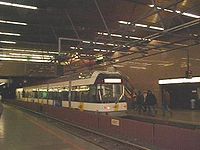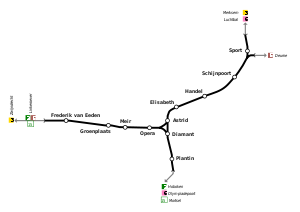
Antwerp Pre-metro
Encyclopedia


Antwerp Tram
The Antwerp Tram is a form of public transport in Antwerp, Belgium. As of 2010 the system features 11 routes, four of which pass partially under the ground ....
system. It is a 1000 mm rail gauge
Rail gauge
Track gauge or rail gauge is the distance between the inner sides of the heads of the two load bearing rails that make up a single railway line. Sixty percent of the world's railways use a standard gauge of . Wider gauges are called broad gauge; smaller gauges, narrow gauge. Break-of-gauge refers...
system, which runs underground in the city centre and further out on surface lines, which are separated from motor traffic. It is intended eventually to evolve into a full metro
Rapid transit
A rapid transit, underground, subway, elevated railway, metro or metropolitan railway system is an electric passenger railway in an urban area with a high capacity and frequency, and grade separation from other traffic. Rapid transit systems are typically located either in underground tunnels or on...
, similar to the Brussels Metro
Brussels Metro
The Brussels Metro is a rapid transit system serving a large part of the Brussels-Capital Region of Belgium. It consists of a network with four metro line services with some shared sections. The metro has 49.9 km of network and 59 stations...
or German Stadtbahn
Stadtbahn
A ' is a tramway or light railway that includes segments built to rapid transit standards, usually as part of a process of conversion to a metro railway, mainly by the building of tunnels in the central city area....
s (light railway
Light railway
Light railway refers to a railway built at lower costs and to lower standards than typical "heavy rail". This usually means the railway uses lighter weight track, and is more steeply graded and tightly curved to avoid civil engineering costs...
s).
History
It was planned at the beginning of the 1970s to build a completely underground network with a length by 15 km and 22 stations. However, due to financial difficulties only 11 stations have been built. The network is now operated by De LijnDe Lijn
Vlaamse Vervoersmaatschappij De Lijn , usually known as simply De Lijn , is a company run by the Flemish government in Belgium to provide public transportation, similar to the way in which Belgian railroads or the postal system is run. It runs about 3650 buses and 359 trams...
.
The first 1.3 km section opened on 25 May 1975 between Opera, Meir and Groenplaats. Further sections were opened in 1980, 1990, 1996 and 2006. The newest station is at Schijnpoort in the northeast of the system.
Stations
- Astrid (opened in 1996, connecting with the Central stationCentral station (Antwerp)Antwerpen-Centraal is the name of the main railway station in the Belgian city of Antwerp. The station is operated by the national railway company NMBS.- History and architecture :...
) - Diamant (opened in 1980, connecting with the Central station)
- Elisabeth (opened in 1996)
- Frederik van Eeden (opened in 1990)
- Groenplaats (opened in 1975)
- Handel (opened in 1996)
- Meir (opened in 1975)
- Opera (opened in 1975)
- Plantin (opened in 1980)
- Schijnpoort (opened in 1996)
- Sport (opened in 1996)
Pegasus-Plan

Under the Pegasus plan (approved in 2004) several tram lines will be built to the eastern suburbs, using some of the tunnels abandoned in the 1980s, including stations at Opera, Astrid, Drink and Morkhoven.

